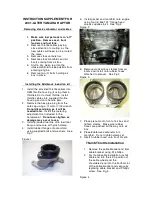
Driving and operation
124
Driving hints
The first 600 miles (1000 km)
Drive your vehicle at v arious speeds. Do
not use full throttle. Never allow the eng ine
to labour at low revs.
Make good use of all gea rs. Depress the
accelerator pedal a maximum of around
three quarters of the ava ila ble ped al travel
in all gears and drive ranges.
Do not drive faster than three quarters of
maximum speed.
Avoid quick starts, sudden a cceleration
and prolonged high-speed driv ing , to
avoid engine d amage and to conserve
fuel.
Do not brake unnecessarily hard for the
first 125 miles (200 km ).
If possib le, a void towing another vehicle.
Never coa st with engine not running
Many units may then not function (e.g.
brake servo unit, power steering, airbag
system). Driving in this manner is a danger
to yourself and others.
Brake servo unit
With the engine not running, the brak e
servo unit is no longer effective once the
brake peda l has been depressed once or
twice. The braking effect is not red uced,
but substantia lly greater foot pressure is
necessary to stop the vehicle.
Pow er steering
Nev er leave the steering wheel on full lock
when the v ehicle is stationary, a s this may
damage the power steering pump.
If the p ow er steering should fail - e.g. when
the vehicle is being towed with the engine
switched off - the v ehicle can still b e
prop erly steered, but considera bly greater
effort is necessary.
Dr iving in mountainous terrain or with a
caravan / trailer
Elec trica lly driven fan; the fan cooling
capacity is not dependent on engine
speed. It is not necessary, therefore, when
driving uphill to shift down into a lower
gear if the vehicle can c lim b in a higher
gear.
Driving in extrem e conditions
When driving in haza rd ous conditions, e.g.
in snow , ice, mud, sand or water, drive
slowly and cautiously to allow for greater
brak ing distances.
If stuck, use 2nd g ear (automatic
transmission in drive rang e
2
) to avoid
spinning the front w heels.
Use sand, tyre cha ins or other non-slip
ma terials to provide traction when stuck in
snow , mud or ice.
Driving through w ater
Before attem pting to drive through water,
check the depth. If the depth is slightly
lower tha n the underbody of your vehicle,
do not attempt to drive throug h it.
Driving too quickly through water can
cause water to enter the engine through
the air inta ke, causing severe dama ge.
Drive slowly, in a high engine rpm in as low
a gear a s p ossible.
Driving with a roof loa d
Do not exceed the perm issible roof load -
see page 216. For safety reasons,
distribute the loa d ev enly a nd secure it
tightly with straps so that it cannot slip. Set
the tyre p ressure to the value given for full
load. Do not drive fa ster than 75 mph
(120 km /h). Check and retighten straps at
freq uent intervals.
Содержание 2009 Antara
Страница 4: ...0 ...
Страница 10: ...6 In brief ...
Страница 227: ...Technical data 223 ...
Страница 235: ...Index 231 ...
Страница 236: ...232 Index ...
















































